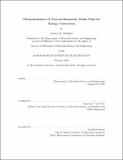Chemomechanics of non-stoichiometric oxide films for energy conversion
Author(s)
Swallow, Jessica G
DownloadFull printable version (42.33Mb)
Other Contributors
Massachusetts Institute of Technology. Department of Materials Science and Engineering.
Advisor
Krystyn J. Van Vliet.
Terms of use
Metadata
Show full item recordAbstract
Electrochemical energy conversion and storage devices including solid oxide fuel cells (SOFCs) and lithium ion batteries (LIBs) are enabled by materials known as "non-stoichiometric oxides" that contain large concentrations of point defects such as oxygen or lithium vacancies. While this non-stoichiometry provides the essential functional properties of ionic conductivity or reactivity that make these materials useful, it also tends to couple to material volume through the effect of chemical expansion. Chemical expansion, or volume coupled to defect concentration, is in turn tied to mechanical variables including stress, strain, and elastic constants. This electrochemomechanical coupling, or interaction between functional properties, defect chemistry, and mechanical variables, can have important consequences for devices operated in extreme environments, where unexpected stress may lead to fracture, or well-engineered strain may enhance device efficiency. Such effects are particularly important in thin film devices, where strain engineering is within reach, undesired fracture can devastate performance, and defect chemistry and related properties can differ from bulk systems. In this thesis, we present a concerted investigation of chemomechanical coupling, including interactions between material chemistry, environmental conditions, stress, strain, and mechanical properties, for films of the model material PrxCe1-xO2-[delta] (PCO) that is a fluorite-structured oxide relevant to SOFC applications. PCO is an excellent model system because of its well-established defect chemistry model and known thermal and chemical expansion coefficients. The thesis begins by first characterizing key chemomechanical effects in PCO, including electrochemically induced high temperature actuation and nonstoichiometry- dependent mechanical properties that are modulated by environmental conditions including temperature and oxygen partial pressure. We then explore the mechanisms and microstructural contributions to these effects via computational modeling and high temperature transmission electron microscopy, identifying ways in which chemomechanical effects in thin film non-stoichiometric oxides differ from those in bulk. Finally, we extend the experimental and computational methods developed in the thesis to characterizing similar effects in Li-storage materials, demonstrating the broad applicability of results across the classes of non-stoichiometric oxides. We first describe an experimental study in which we developed a novel method of detecting chemical expansion on short time scales in the model system PCO and characterized material deformation for a range of conditions of temperature and effective oxygen partial pressure (pO2). In this method, electrically-stimulated chemical expansion caused mechanical deflection of a substrate, an effect that for PCO was enhanced for elevated temperatures or reducing conditions ...
Description
Thesis: Ph. D., Massachusetts Institute of Technology, Department of Materials Science and Engineering, 2018. This electronic version was submitted by the student author. The certified thesis is available in the Institute Archives and Special Collections. Cataloged from student-submitted PDF version of thesis. Includes bibliographical references.
Date issued
2018Department
Massachusetts Institute of Technology. Department of Materials Science and EngineeringPublisher
Massachusetts Institute of Technology
Keywords
Materials Science and Engineering.